Low-Emission Waste-to-Energy Method of Liquid Fuel Combustion with a Mixture of Superheated Steam and Carbon Dioxide
Abstract
:1. Introduction
1.1. Low-Temperature Combustion
1.2. Steam and Carbon Dioxide as Diluent Gases in the Systems of Low-Temperature Combustion
1.3. The Original Method of Low-Emission Combustion of Liquid Combustible Waste in a High-Velocity Jet of Superheated Steam
2. Materials and Methods
2.1. Burner
2.2. Experimental Setup
2.3. Measurement Methods
- tin and tout are coolant (water) temperatures at the entrance and exit of the calorimeter. They are defined as the average throughout the period of measurement in a steady-state thermal regime.
- Cp = f(t) and ρ = f(t) are the coolant (water) heat capacity and density. They are determined by the average temperature at the inlet and outlet of the calorimeter using thermodynamic tables.
- h = f(t;p) is the steam and carbon dioxide enthalpy. It is defined as a function of the state of the matter on its parameters using thermodynamic tables.
- T is the burner surface temperature; it is identified by measurement with a Fluke Ti32 thermal imager.
- CCO2 and CN2 are the heat capacities of flue gases. They are determined from the thermodynamic tables of substances.
2.4. Selection of Operating Parameters
3. Results and Discussion
4. Conclusions
Author Contributions
Funding
Data Availability Statement
Conflicts of Interest
Nomenclature
| CIM | carbon dioxide injection method |
| HHV | higher heating value |
| LHV | lower heating value |
| SCIM | superheated steam and carbon dioxide injection method |
| SIM | superheated steam injection method |
| FCO2 | mass flow rate of CO2, kg/s |
| Fv | mass flow rate of water vapor, kg/s |
| G | coolant flow rate, m3/h |
| h | specific enthalpy, J/kg |
| NOx(ppm) | measured content of nitrogen oxides in flue gases, ppm |
| Omeas | measured content of oxygen in flue gases, vol. % |
| Q | heat release, J |
| Qg | heat loss with gases leaving the calorimeter, J |
| Qin | heat in the coolant at the calorimeter inlet, J |
| Qlhv | lower specific calorific value of fuel, kWh/kg |
| Qout | heat in the coolant at the calorimeter outlet, J |
| Qr | heat loss via radiation from the burner surface, J |
| Qs | heat introduced with spraying agent, J |
| S | radiant surface area of the burner, m2 |
| T | burner surface temperature, K |
| t | coolant temperature, K |
| Tamb | ambient temperature, K |
| Tc | thermal junction temperature, K |
| tin | coolant temperature at the calorimeter inlet, K |
| tout | coolant temperature at the calorimeter outlet, K |
| Tout | temperature of gases leaving the calorimeter, K |
| V | gas velocity, m/s |
| V0 | theoretical volume of dry air required for complete combustion of 1 kg of fuel, m3/kg |
| VCO2 | the volume of carbon dioxide used to spray the fuel, m3/kg |
| ε | emissivity |
| η | gas viscosity coefficient, Pa·s |
| λ | gas heat conductivity coefficient, W/m·K |
| ρ | density, kg/m3 |
| σ | Stefan-Boltzmann constant, kg/s3K4 |
| τ | measurement time, s |
References
- World Energy Outlook 2022—Analysis—IEA. Available online: https://www.iea.org/reports/world-energy-outlook-2022 (accessed on 4 April 2023).
- Pathways to Net Zero: The Impact of Clean Energy Research. Available online: https://www.iea.org/reports/net-zero-by-2050 (accessed on 8 February 2023).
- World Energy & Climate Statistics—Yearbook. 2021. Available online: https://yearbook.enerdata.net/ (accessed on 26 April 2023).
- James, B. Cost and Performance Baseline for Fossil Energy Plants Volume 1: Bituminous Coal and Natural Gas to Electricity; DOE/NETL-2010/1397; National Energy Technology Laboratory: Albany, OR, USA, 2010.
- Wang, T.; Stiegel, G. Integrated Gasification Combined Cycle (IGCC) Technologies, 1st ed.; Elsevier: Amsterdam, The Netherlands, 2016; ISBN 9780081001851. [Google Scholar] [CrossRef]
- Lam, S.S.; Liew, R.K.; Jusoh, A.; Chong, C.T.; Ani, F.N.; Chase, H.A. Progress in waste oil to sustainable energy, with emphasis on pyrolysis techniques. Renew. Sustain. Energy Rev. 2016, 53, 741–753. [Google Scholar] [CrossRef]
- Ramirez, D.; Collins, C.D. Maximisation of oil recovery from an oil-water separator sludge: Influence of type, concentration, and application ratio of surfactants. Waste Manag. 2018, 82, 100–110. [Google Scholar] [CrossRef] [PubMed]
- Solid Waste Management. Available online: https://www.worldbank.org/en/topic/urbandevelopment/brief/solid-waste-management (accessed on 21 September 2022).
- Bosmans, A.; Vanderreydt, I.; Geysen, D.; Helsen, L. The crucial role of Waste-to-Energy technologies in enhanced landfill mining: A technology review. J. Clean. Prod. 2013, 55, 10–23. [Google Scholar] [CrossRef] [Green Version]
- Breeze, P. Energy from Waste; Elsevier: Amsterdam, The Netherlands, 2018; ISBN 9780081010426. [Google Scholar] [CrossRef]
- Rogoff, M.J.; Screve, F. Waste-to-Energy; Elsevier: Amsterdam, The Netherlands, 2019; ISBN 9780128160794. [Google Scholar] [CrossRef]
- Malekli, M.; Aslani, A.; Zolfaghari, Z.; Zahedi, R.; Moshari, A. Advanced bibliometric analysis on the development of natural gas combined cycle power plant with CO2 capture and storage technology. Sustain. Energy Technol. Assess. 2022, 52, 102339. [Google Scholar] [CrossRef]
- Lu, X.; Han, D.; Huang, Z. Fuel design and management for the control of advanced compression-ignition combustion modes. Prog. Energy Combust. Sci. 2011, 37, 741–783. [Google Scholar] [CrossRef]
- Kook, S.; Bae, C.; Miles, P.C.; Choi, D.; Pickett, L.M. The Influence of Charge Dilution and Injection Timing on Low-Temperature Diesel Combustion and Emissions; SAE Technical Papers; SAE International: Warrendale, PA, USA, 2005. [Google Scholar] [CrossRef] [Green Version]
- Yao, M.; Zheng, Z.; Liu, H. Progress and recent trends in homogeneous charge compression ignition (HCCI) engines. Prog. Energy Combust. Sci. 2009, 35, 398–437. [Google Scholar] [CrossRef]
- Hachem, J.; Schuhler, T.; Orhon, D.; Cuif-Sjostrand, M.; Zoughaib, A.; Molière, M. Exhaust gas recirculation applied to single-shaft gas turbines: An energy and exergy approach. Energy 2022, 238, 121656. [Google Scholar] [CrossRef]
- Climent, H.; Dolz, V.; Pla, B.; González-Domínguez, D. Analysis on the potential of EGR strategy to reduce fuel consumption in hybrid powertrains based on advanced gasoline engines under simulated driving cycle conditions. Energy Convers. Manag. 2022, 266, 115830. [Google Scholar] [CrossRef]
- Takaki, D.; Tsuchida, H.; Kobara, T.; Akagi, M.; Tsuyuki, T.; Nagamine, M. Study of an EGR System for Downsizing Turbocharged Gasoline Engine to Improve Fuel Economy; SAE Technical Papers; SAE International: Warrendale, PA, USA, 2014; Volume 1. [Google Scholar] [CrossRef]
- Liu, H.; Zhang, L.; Li, Q.; Zhu, H.; Deng, L.; Liu, Y.; Che, D. Effect of FGR position on the characteristics of combustion, emission and flue gas temperature deviation in a 1000 MW tower-type double-reheat boiler with deep-air-staging. Fuel 2019, 246, 285–294. [Google Scholar] [CrossRef]
- Yan, J.; Zheng, X.; Lu, X.; Liu, Z.; Fan, X. Enhanced combustion behavior and NOx reduction performance in a CFB combustor by combining flue gas recirculation with air-staging: Effect of injection position. J. Energy Inst. 2021, 96, 294–309. [Google Scholar] [CrossRef]
- Zhang, P.; Shao, Y.; Niu, J.; Zeng, X.; Zheng, X.; Wu, C. Effect of low-nitrogen combustion system with flue gas circulation technology on the performance of NOx emission in waste-to-energy power plant. Chem. Eng. Process.—Process Intensif. 2022, 175, 108910. [Google Scholar] [CrossRef]
- Warnatz, J.; Maas, U.; Dibble, R.W. Combustion; Springer: Berlin/Heidelberg, Germany, 2006; ISBN 978-3-540-25992-3. [Google Scholar] [CrossRef]
- Kobayashi, H.; Hagiwara, H.; Kaneko, H.; Ogami, Y. Effects of CO2 dilution on turbulent premixed flames at high pressure and high temperature. Proc. Combust. Inst. 2007, 31, 1451–1458. [Google Scholar] [CrossRef]
- Li, A.; Zheng, Z.; Peng, T. Effect of water injection on the knock, combustion, and emissions of a direct injection gasoline engine. Fuel 2020, 268, 117376. [Google Scholar] [CrossRef]
- Lee, M.C.; Seo, S.B.; Yoon, J.; Kim, M.; Yoon, Y. Experimental study on the effect of N2, CO2, and steam dilution on the combustion performance of H2 and CO synthetic gas in an industrial gas turbine. Fuel 2012, 102, 431–438. [Google Scholar] [CrossRef]
- Le Cong, T.; Dagaut, P. Experimental and Detailed Modeling Study of the Effect of Water Vapor on the Kinetics of Combustion of Hydrogen and Natural Gas, Impact on NOx. Energy Fuels 2009, 23, 725–734. [Google Scholar] [CrossRef]
- Albin, E.; Nawroth, H.; Göke, S.; D’Angelo, Y.; Paschereit, C.O. Experimental investigation of burning velocities of ultra-wet methane-air-steam mixtures. Fuel Process. Technol. 2013, 107, 27–35. [Google Scholar] [CrossRef] [Green Version]
- Zou, C.; Song, Y.; Li, G.; Cao, S.; He, Y.; Zheng, C. The chemical mechanism of steam’s effect on the temperature in methane oxy-steam combustion. Int. J. Heat Mass Transf. 2014, 75, 12–18. [Google Scholar] [CrossRef]
- Honzawa, T.; Kai, R.; Seino, M.; Nishiie, T.; Suzuki, Y.; Okada, A.; Wazaki, K.; Kurose, R. Numerical and experimental investigations on turbulent combustion fields generated by large-scale submerged combustion vaporizer burners with water spray equipment. J. Nat. Gas Sci. Eng. 2020, 76, 103158. [Google Scholar] [CrossRef]
- Cui, G.; Dong, Z.; Wang, S.; Xing, X.; Shan, T.; Li, Z. Effect of the water on the flame characteristics of methane hydrate combustion. Appl. Energy 2020, 259, 114205. [Google Scholar] [CrossRef]
- Donohoe, N.; Heufer, K.A.; Aul, C.J.; Petersen, E.L.; Bourque, G.; Gordon, R.; Curran, H.J. Influence of steam dilution on the ignition of hydrogen, syngas and natural gas blends at elevated pressures. Combust. Flame 2015, 162, 1126–1135. [Google Scholar] [CrossRef] [Green Version]
- Allam, R.; Martin, S.; Forrest, B.; Fetvedt, J.; Lu, X.; Freed, D.; Brown, G.W.; Sasaki, T.; Itoh, M.; Manning, J. Demonstration of the Allam Cycle: An Update on the Development Status of a High Efficiency Supercritical Carbon Dioxide Power Process Employing Full Carbon Capture. Energy Procedia 2017, 114, 5948–5966. [Google Scholar] [CrossRef]
- Datsenko, V.V.; Zeigarnik, Y.A.; Kalashnikova, E.O.; Kosoy, A.A.; Kosoy, A.S.; Sinkevich, M.V. Combined cycle plants with complete capturing of carbon dioxide for clean power projects. Thermophys. Aeromech. 2021, 27, 775–781. [Google Scholar] [CrossRef]
- Gutiérrez, F.A.; García-Cuevas, L.M.; Sanz, W. Comparison of cryogenic and membrane oxygen production implemented in the Graz cycle. Energy Convers. Manag. 2022, 271, 116325. [Google Scholar] [CrossRef]
- Alekseenko, S.V.; Shchinnikov, P.A.; Sadkin, I.S. Effect of thermodynamic parameters on energy characteristics of CO2 power cycles during oxygen combustion of methane. Thermophys. Aeromech. 2023, 30, 83–92. [Google Scholar] [CrossRef]
- Crespi, F.; Gavagnin, G.; Sánchez, D.; Martínez, G.S. Supercritical carbon dioxide cycles for power generation: A review. Appl. Energy 2017, 195, 152–183. [Google Scholar] [CrossRef]
- Darabkhani, H.G.; Varasteh, H.; Bazooyar, B. Oxyturbine power cycles and gas-CCS technologies. In Carbon Capture Technologies for Gas-Turbine-Based Power Plants; Elsevier: Amsterdam, The Netherlands, 2023; pp. 39–74. ISBN 978-0-12-818868-2. [Google Scholar] [CrossRef]
- Kobayashi, H.; Yata, S.; Ichikawa, Y.; Ogami, Y. Dilution effects of superheated water vapor on turbulent premixed flames at high pressure and high temperature. Proc. Combust. Inst. 2009, 32, 2607–2614. [Google Scholar] [CrossRef]
- Xie, Y.; Wang, J.; Xu, N.; Yu, S.; Huang, Z. Comparative study on the effect of CO2 and H2O dilution on laminar burning characteristics of CO/H2/air mixtures. Int. J. Hydrog. Energy 2014, 39, 3450–3458. [Google Scholar] [CrossRef]
- Wang, Z.H.; Weng, W.B.; He, Y.; Li, Z.S.; Cen, K.F. Effect of H2/CO ratio and N2/CO2 dilution rate on laminar burning velocity of syngas investigated by direct measurement and simulation. Fuel 2015, 141, 285–292. [Google Scholar] [CrossRef]
- Weng, W.B.; Wang, Z.H.; He, Y.; Whiddon, R.; Zhou, Y.J.; Li, Z.S.; Cen, K.F. Effect of N2/CO2 dilution on laminar burning velocity of H2–CO–O2 oxy-fuel premixed flame. Int. J. Hydrog. Energy 2015, 40, 1203–1211. [Google Scholar] [CrossRef]
- Vu, T.M.; Park, J.; Kwon, O.B.; Bae, D.S.; Yun, J.H.; Keel, S.I. Effects of diluents on cellular instabilities in outwardly propagating spherical syngas–air premixed flames. Int. J. Hydrog. Energy 2010, 35, 3868–3880. [Google Scholar] [CrossRef]
- Liu, F.; Karataş, A.E.; Gülder, Ö.L.; Gu, M. Numerical and experimental study of the influence of CO2 and N2 dilution on soot formation in laminar coflow C2H4/air diffusion flames at pressures between 5 and 20 atm. Combust. Flame 2015, 162, 2231–2247. [Google Scholar] [CrossRef] [Green Version]
- Giurcan, V.; Razus, D.; Mitu, M.; Oancea, D. Prediction of flammability limits of fuel-air and fuel-air-inert mixtures from explosivity parameters in closed vessels. J. Loss Prev. Process Ind. 2015, 34, 65–71. [Google Scholar] [CrossRef]
- Tran, M.V.; Scribano, G.; Chong, C.T.; Ng, J.H.; Ho, T.X. Numerical and experimental study of the influence of CO2 dilution on burning characteristics of syngas/air flame. J. Energy Inst. 2019, 92, 1379–1387. [Google Scholar] [CrossRef]
- Vigriyanov, M.S.; Anufriev, I.S.; Kopyev, E.P.; Sharypov, O.V.; Shadrin, E.Y. Burner device 2018.
- Anufriev, I.S.; Kopyev, E.P.; Sadkin, I.S.; Mukhina, M.A. Diesel and waste oil combustion in a new steam burner with low NOX emission. Fuel 2021, 290, 120100. [Google Scholar] [CrossRef]
- Anufriev, I.S.; Kopyev, E.P.; Sadkin, I.S.; Mukhina, M.A. NOx reduction by steam injection method during liquid fuel and waste burning. Process Saf. Environ. Prot. 2021, 152, 240–248. [Google Scholar] [CrossRef]
- Anufriev, I.S.; Shadrin, E.Y.; Kopyev, E.P.; Alekseenko, S.V.; Sharypov, O.V. Study of liquid hydrocarbons atomization by supersonic air or steam jet. Appl. Therm. Eng. 2019, 163, 114400. [Google Scholar] [CrossRef]
- Sadkin, I.S.; Kopyev, E.P.; Mukhina, M.A.; Anufriev, I.S. Experimental study of the characteristics of heptane combustion in a high-speed steam jet. J. Phys. Conf. Ser. 2022, 2233, 012001. [Google Scholar] [CrossRef]
- Alekseenko, S.V.V.; Anufriev, I.S.S.; Vigriyanov, M.S.S.; Kopyev, E.P.P.; Sadkin, I.S.S.; Sharypov, O.V. Burning of Heavy Fuel Oil in a Steam Jet in a New Burner. J. Appl. Mech. Tech. Phys. 2020, 61, 324–330. [Google Scholar] [CrossRef]
- Anufriev, I.; Kovyev, E.; Alekseenko, S.S.; Sharypov, O.; Butakov, E.; Vigriyanov, M.; Sadkin, I. Cleaner crude oil combustion during superheated steam atomization. Therm. Sci. 2021, 25, 331–345. [Google Scholar] [CrossRef]
- Anufriev, I.S.; Kopyev, E.P.; Alekseenko, S.V.; Sharypov, O.V.; Vigriyanov, M.S. New ecology safe waste-to-energy technology of liquid fuel combustion with superheated steam. Energy 2022, 250, 123849. [Google Scholar] [CrossRef]
- Unique Research Facility USU “Large-Scale Thermo-Hydrodynamic Setup for Studying the Thermal and Gas-Dynamic Characteristics of Power Plants”. Available online: http://ckp-rf.ru/usu/73570/ (accessed on 19 April 2023).
- Anufriev, I.S.; Kopyev, E.P. Diesel fuel combustion by spraying in a superheated steam jet. Fuel Process. Technol. 2019, 192, 154–169. [Google Scholar] [CrossRef]
- DIN EN 267:2011-11; Automatic Forced Draught Burners for Liquid Fuels. NORMSERVIS: Hamry nad Sázavou, Czech Republic, 2011.
- Kaskan, W.E. The dependence of flame temperature on mass burning velocity. Symp. Combust. 1957, 6, 134–143. [Google Scholar] [CrossRef]
- Anufriev, I.S.; Krasinsky, D.V.; Shadrin, E.Y.; Kopyev, E.P.; Sharypov, O.V. Investigation of the structure of the gas flow from the nozzle of a spray-type burner. Thermophys. Aeromech. 2019, 26, 657–672. [Google Scholar] [CrossRef]
- Kopyev, E.P.; Shadrin, E.Y.; Sadkin, I.S.; Mukhina, M.A.; Shimchenko, S.Y. Experimental Study of Combustion of Liquid Hydrocarbons under the Conditions of Steam Gasification in the Presence of a Diluent Gas. Combust. Explos. Shock Waves 2022, 58, 457–463. [Google Scholar] [CrossRef]
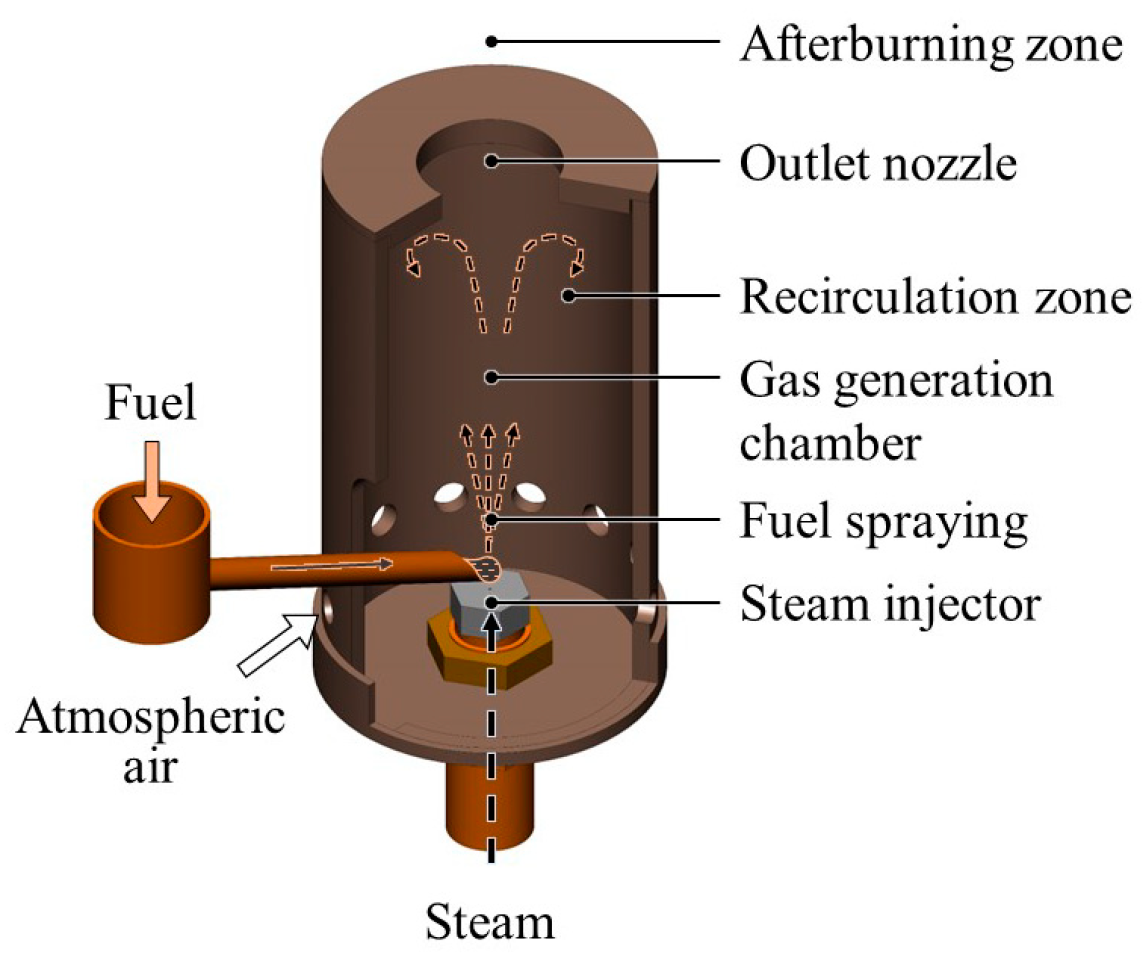
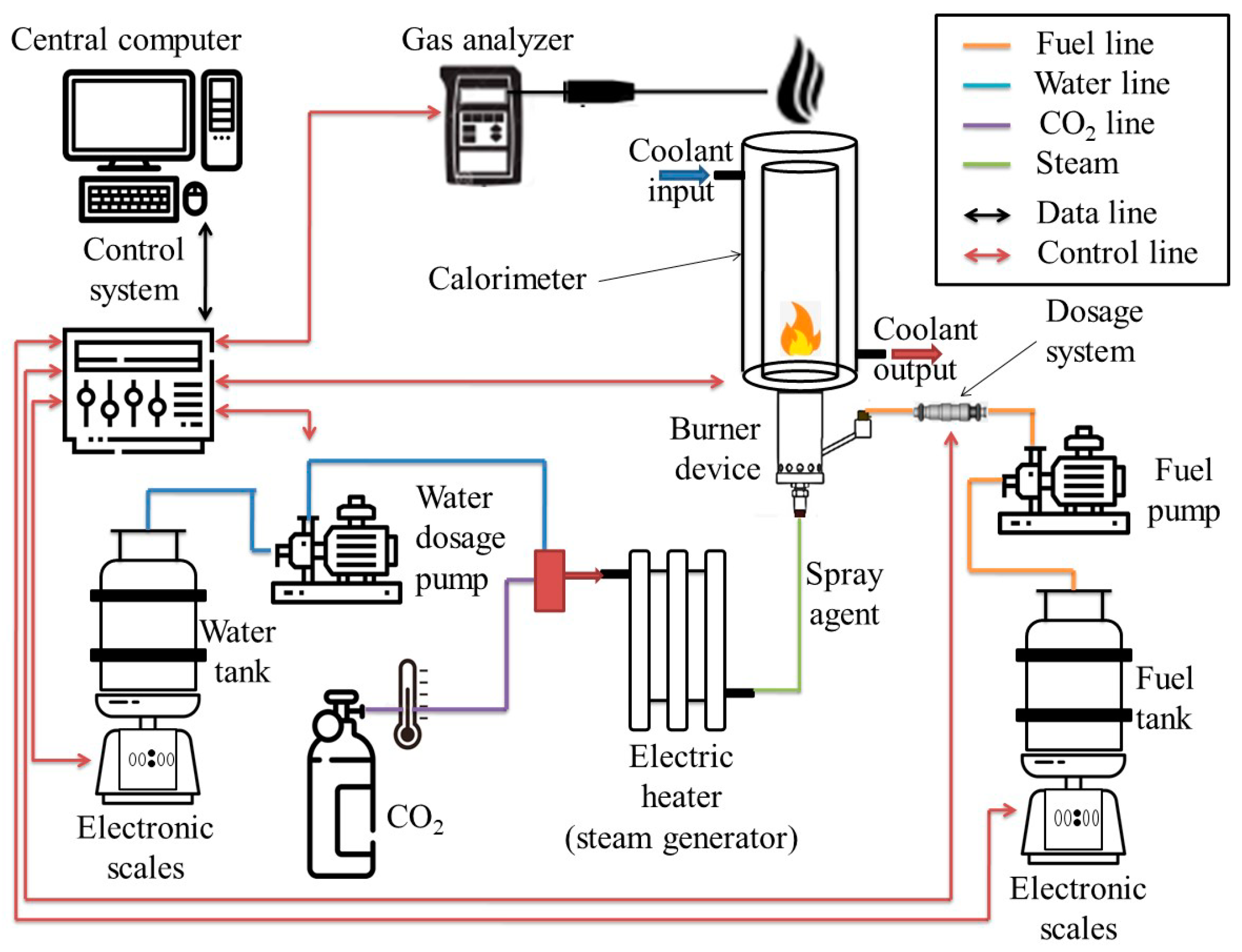


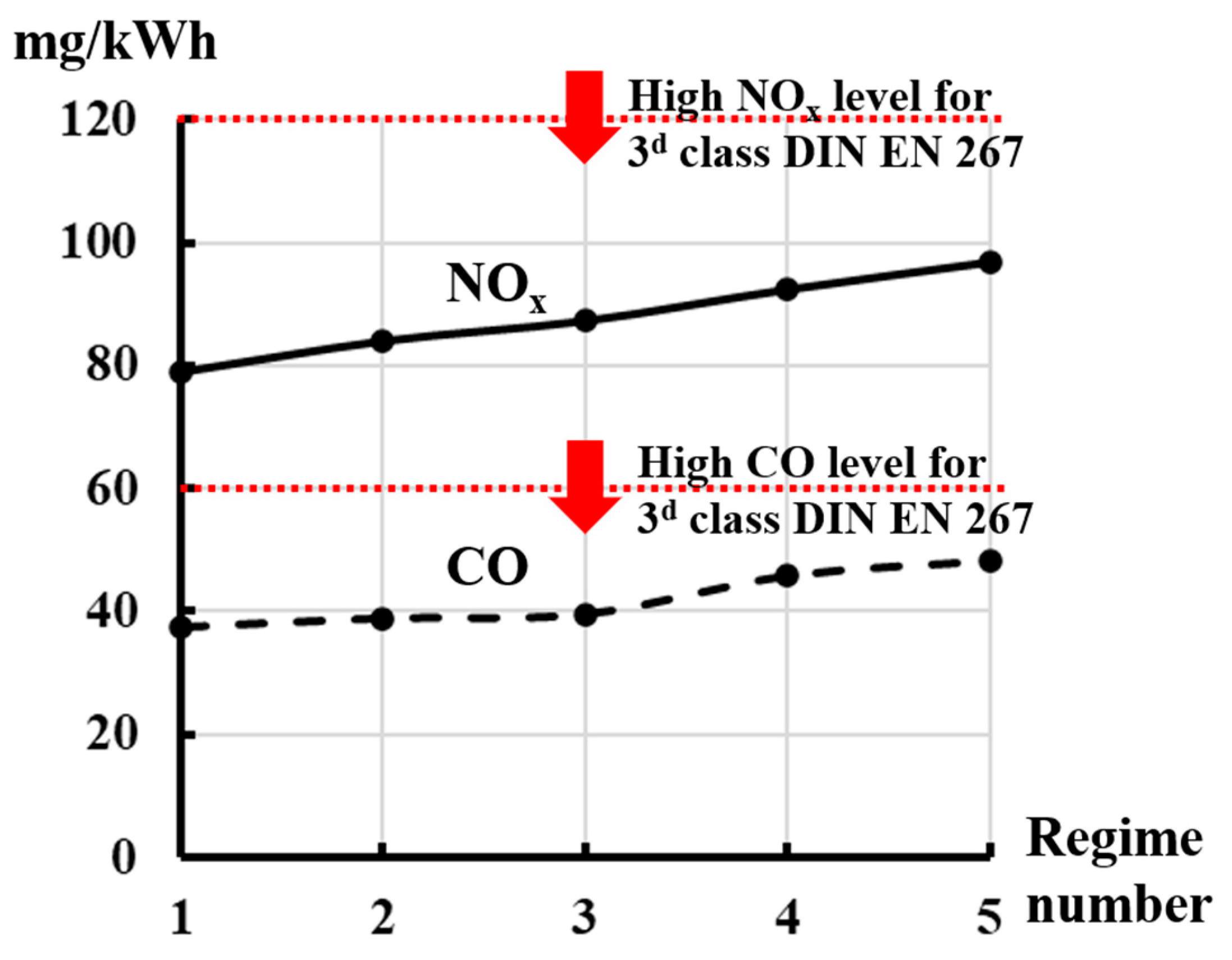
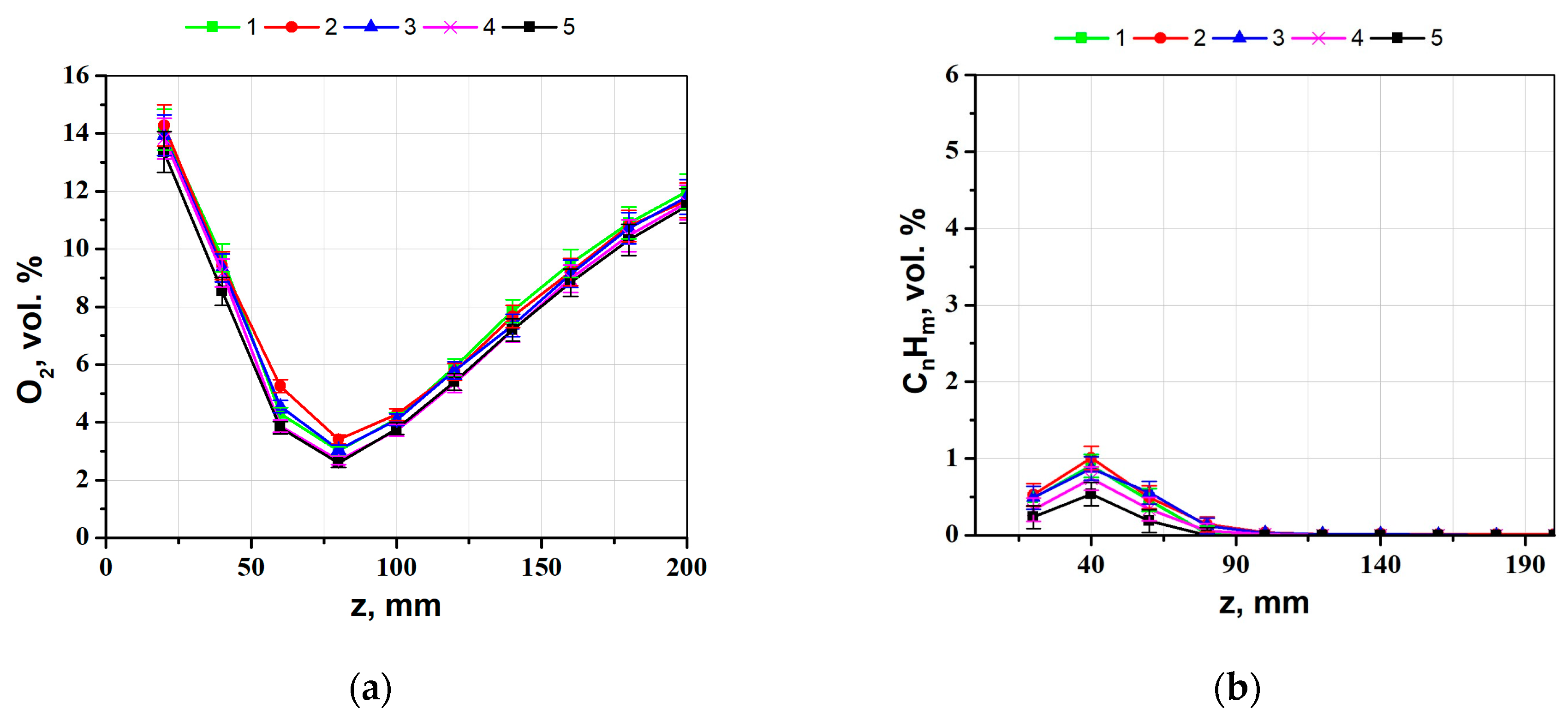
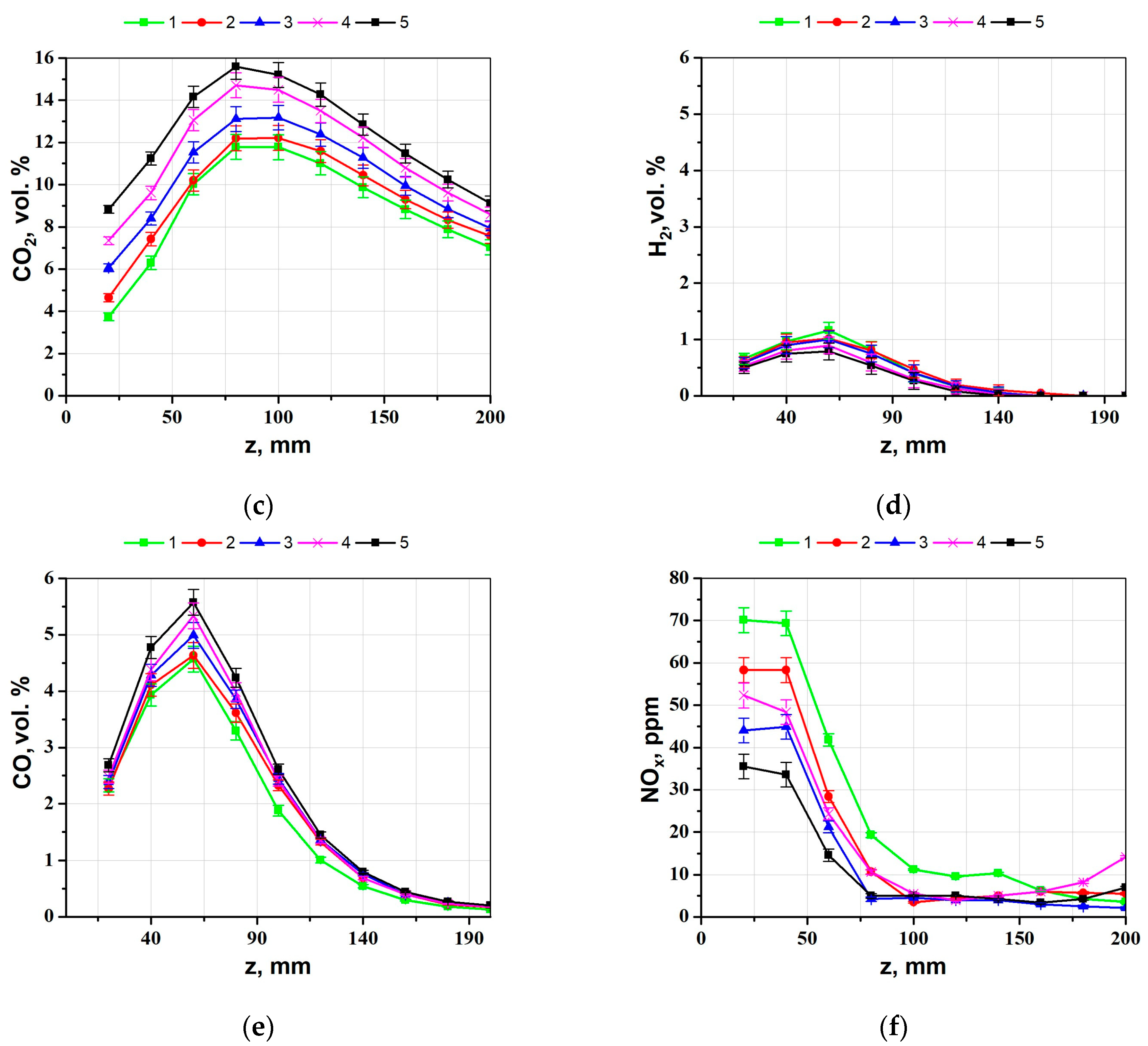
| Regime Number | Fuel Flow Rate, kg/h | Steam Flow Rate, kg/h | CO2 Flow Rate, kg/h | CO2 Mass Content in the Spray Mixture, % | Jet Momentum [57], N | Temperature of Steam/CO2/Mixture, °C |
|---|---|---|---|---|---|---|
| 1 | 1.2 | 0.8 | 0 | 0 | 0.203 | 250 |
| 2 | 0.6 | 0.34 | 36.2 | 0.207 | ||
| 3 | 0.4 | 0.64 | 61.52 | 0.206 | ||
| 4 | 0.2 | 0.95 | 82.61 | 0.205 | ||
| 5 | 0 | 1.3 | 100 | 0.207 |
| Properties: | Density, kg/m3 | Viscosity, cSt | C, % | H, % | S, % | N, % | HHV/LHV, MJ/kg |
|---|---|---|---|---|---|---|---|
| Value: | 840 | 4.1 | 84.6 | 13.6 | 0.4 | 0.6 | 42.3/44.9 |
| Regime Number | O2, % | CO2, % | CO, ppm | NOx, ppm | Q, MJ/kg |
|---|---|---|---|---|---|
| 1 | 4.06 | 13.29 | 27 | 35 | 45.14 |
| 2 | 3.85 | 14.32 | 29 | 38 | 46 |
| 3 | 3.65 | 15.3 | 30 | 40 | 45.87 |
| 4 | 3.4 | 16.36 | 35 | 43 | 45.39 |
| 5 | 3.19 | 17.48 | 37 | 45 | 45.61 |
Disclaimer/Publisher’s Note: The statements, opinions and data contained in all publications are solely those of the individual author(s) and contributor(s) and not of MDPI and/or the editor(s). MDPI and/or the editor(s) disclaim responsibility for any injury to people or property resulting from any ideas, methods, instructions or products referred to in the content. |
© 2023 by the authors. Licensee MDPI, Basel, Switzerland. This article is an open access article distributed under the terms and conditions of the Creative Commons Attribution (CC BY) license (https://creativecommons.org/licenses/by/4.0/).
Share and Cite
Sadkin, I.; Mukhina, M.; Kopyev, E.; Sharypov, O.; Alekseenko, S. Low-Emission Waste-to-Energy Method of Liquid Fuel Combustion with a Mixture of Superheated Steam and Carbon Dioxide. Energies 2023, 16, 5745. https://doi.org/10.3390/en16155745
Sadkin I, Mukhina M, Kopyev E, Sharypov O, Alekseenko S. Low-Emission Waste-to-Energy Method of Liquid Fuel Combustion with a Mixture of Superheated Steam and Carbon Dioxide. Energies. 2023; 16(15):5745. https://doi.org/10.3390/en16155745
Chicago/Turabian StyleSadkin, Ivan, Mariia Mukhina, Evgeny Kopyev, Oleg Sharypov, and Sergey Alekseenko. 2023. "Low-Emission Waste-to-Energy Method of Liquid Fuel Combustion with a Mixture of Superheated Steam and Carbon Dioxide" Energies 16, no. 15: 5745. https://doi.org/10.3390/en16155745




